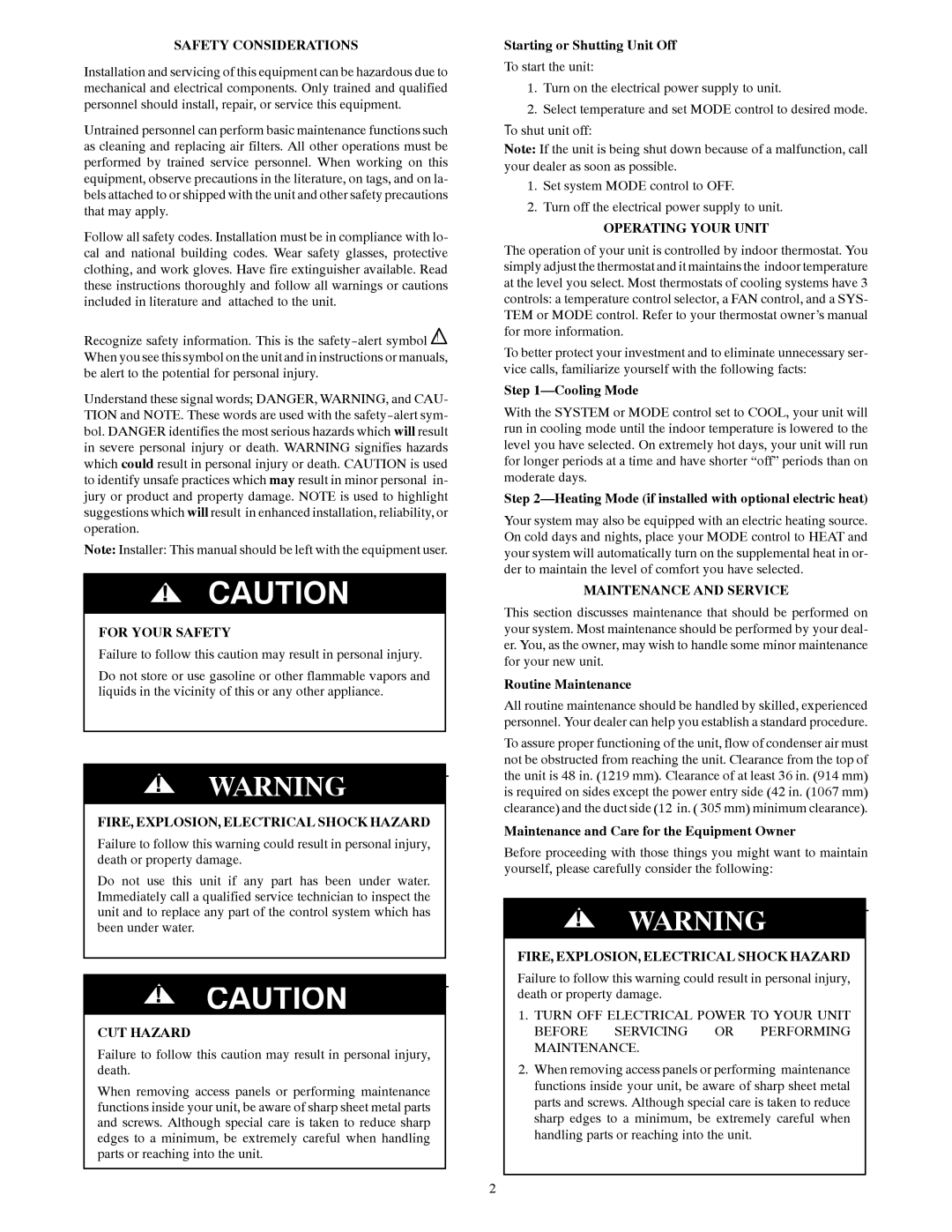SAFETY CONSIDERATIONS
Installation and servicing of this equipment can be hazardous due to mechanical and electrical components. Only trained and qualified personnel should install, repair, or service this equipment.
Untrained personnel can perform basic maintenance functions such as cleaning and replacing air filters. All other operations must be performed by trained service personnel. When working on this equipment, observe precautions in the literature, on tags, and on la- bels attached to or shipped with the unit and other safety precautions that may apply.
Follow all safety codes. Installation must be in compliance with lo- cal and national building codes. Wear safety glasses, protective clothing, and work gloves. Have fire extinguisher available. Read these instructions thoroughly and follow all warnings or cautions included in literature and attached to the unit.
Recognize safety information. This is the safety-alert symbol ! When you see this symbol on the unit and in instructions or manuals, be alert to the potential for personal injury.
Understand these signal words; DANGER, WARNING, and CAU- TION and NOTE. These words are used with the safety-alert sym- bol. DANGER identifies the most serious hazards which will result in severe personal injury or death. WARNING signifies hazards which could result in personal injury or death. CAUTION is used to identify unsafe practices which may result in minor personal in- jury or product and property damage. NOTE is used to highlight suggestions which will result in enhanced installation, reliability, or operation.
Note: Installer: This manual should be left with the equipment user.
!CAUTION
FOR YOUR SAFETY
Failure to follow this caution may result in personal injury.
Do not store or use gasoline or other flammable vapors and liquids in the vicinity of this or any other appliance.
!WARNING
FIRE, EXPLOSION, ELECTRICAL SHOCK HAZARD
Failure to follow this warning could result in personal injury, death or property damage.
Do not use this unit if any part has been under water. Immediately call a qualified service technician to inspect the unit and to replace any part of the control system which has been under water.
!CAUTION
CUT HAZARD
Failure to follow this caution may result in personal injury, death.
When removing access panels or performing maintenance functions inside your unit, be aware of sharp sheet metal parts and screws. Although special care is taken to reduce sharp edges to a minimum, be extremely careful when handling parts or reaching into the unit.
Starting or Shutting Unit Off
To start the unit:
1.Turn on the electrical power supply to unit.
2.Select temperature and set MODE control to desired mode.
To shut unit off:
Note: If the unit is being shut down because of a malfunction, call your dealer as soon as possible.
1.Set system MODE control to OFF.
2.Turn off the electrical power supply to unit.
OPERATING YOUR UNIT
The operation of your unit is controlled by indoor thermostat. You simply adjust the thermostat and it maintains the indoor temperature at the level you select. Most thermostats of cooling systems have 3 controls: a temperature control selector, a FAN control, and a SYS- TEM or MODE control. Refer to your thermostat owner’s manual for more information.
To better protect your investment and to eliminate unnecessary ser- vice calls, familiarize yourself with the following facts:
Step 1—Cooling Mode
With the SYSTEM or MODE control set to COOL, your unit will run in cooling mode until the indoor temperature is lowered to the level you have selected. On extremely hot days, your unit will run for longer periods at a time and have shorter “off” periods than on moderate days.
Step 2—Heating Mode (if installed with optional electric heat)
Your system may also be equipped with an electric heating source. On cold days and nights, place your MODE control to HEAT and your system will automatically turn on the supplemental heat in or- der to maintain the level of comfort you have selected.
MAINTENANCE AND SERVICE
This section discusses maintenance that should be performed on your system. Most maintenance should be performed by your deal- er. You, as the owner, may wish to handle some minor maintenance for your new unit.
Routine Maintenance
All routine maintenance should be handled by skilled, experienced personnel. Your dealer can help you establish a standard procedure.
To assure proper functioning of the unit, flow of condenser air must not be obstructed from reaching the unit. Clearance from the top of the unit is 48 in. (1219 mm). Clearance of at least 36 in. (914 mm) is required on sides except the power entry side (42 in. (1067 mm) clearance) and the duct side (12 in. ( 305 mm) minimum clearance).
Maintenance and Care for the Equipment Owner
Before proceeding with those things you might want to maintain yourself, please carefully consider the following:
!WARNING
FIRE, EXPLOSION, ELECTRICAL SHOCK HAZARD
Failure to follow this warning could result in personal injury, death or property damage.
1.TURN OFF ELECTRICAL POWER TO YOUR UNIT BEFORE SERVICING OR PERFORMING MAINTENANCE.
2.When removing access panels or performing maintenance functions inside your unit, be aware of sharp sheet metal parts and screws. Although special care is taken to reduce sharp edges to a minimum, be extremely careful when handling parts or reaching into the unit.

